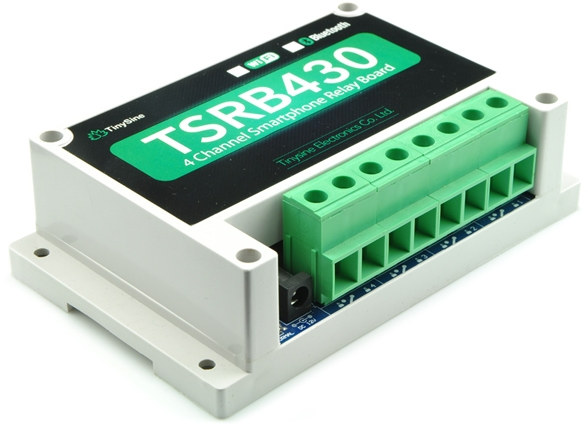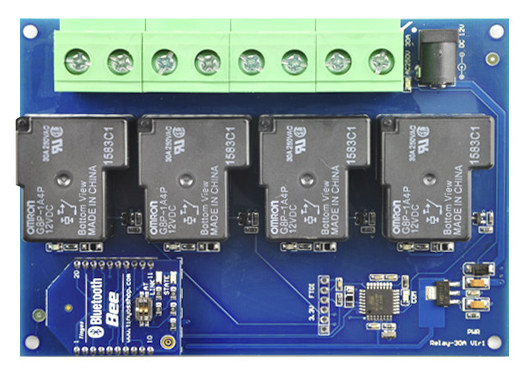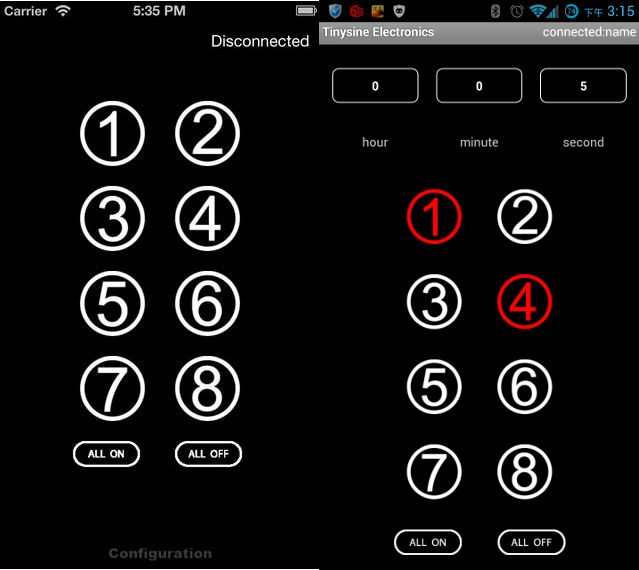It’s now fairly easy to find the hardware to create WiFi or Bluetooth controlled relays, but you usually have to design your own enclosure and Android app, and if you’d like something that’s ready to use out of the box TinySine wireless relays such as TSRB430 (Bluetooth) or TSRW430 (WiFi) might be an interesting option. There;s also a version with USB control.
 TSRB430 / TSRB430 / TSRU430 specifications:
TSRB430 / TSRB430 / TSRU430 specifications:
- 4x Omron G8P 30A/250VAC | 20A/28VDC relay; SPST-NO (normally open) types.
- Connectivity – XBEE module either:
- Bluetooth Bee module based on CSR BC417143 Bluetooth 2.0 chipset
- Roving Networks WiFi Bee module with 802.11 b/g radio
- USB Bee module with a CP2102 USB to UART chip
- Power Supply – 12V/1A via 2.1mm jack with positive core polarity
- Dimensions – 122mm x 87mm x x 31mm (board)
 There are also versions with 2 and 8 relays. I kind of wish they had models taking 220V AC input instead of 12V, as I’ve recently setup a WiFi relay for a water pump with NodeMCU, and I had to use an external power supply making things a little messier than necessary… The case provided is not splash proof either, but at least it can be wall-mounted. This kind of boards are better with some safety certifications such as UL or TUV, but I could not find any references to those on the website.
There are also versions with 2 and 8 relays. I kind of wish they had models taking 220V AC input instead of 12V, as I’ve recently setup a WiFi relay for a water pump with NodeMCU, and I had to use an external power supply making things a little messier than necessary… The case provided is not splash proof either, but at least it can be wall-mounted. This kind of boards are better with some safety certifications such as UL or TUV, but I could not find any references to those on the website.

Android or iOS apps are available as apks (Wifi or Bluetooth) or on the Apple Store, and all let you turn on or off the relay, and the Android apps also allows you to set timers up to 24 hours. The company did not feel it important to release the app source code to let their customer easily modify it however… But at least the commands set to control the XBEE module is provided in the user’s manual, so you could always roll your own, or even exchange the XBEE module with another using your preferred standard. A Windows based “test program” can also be used instead
The modules are probably not quite as cost optimized as they could have been, but still relatively affordable with TSRW430 selling for $79, TSRB430 for $69.00, and TSRU430 for $59.95, with all three models including an enclosure. Shipping is not included and adds about$10 for air mail shipping by Hong Kong post. You can also browse their website as they have many models. Alternatively some TinySine relays are sold on eBay and Amazon US.

Jean-Luc started CNX Software in 2010 as a part-time endeavor, before quitting his job as a software engineering manager, and starting to write daily news, and reviews full time later in 2011.
Support CNX Software! Donate via cryptocurrencies, become a Patron on Patreon, or purchase goods on Amazon or Aliexpress





Devices like these need to provide bindings for Domoticz and OpenHAB as open source for all protocols to be interesting
@Harley
The command sets is available, so it could be integrated without too much trouble.
I’d also expect a price closer to $30 for such device, They did use Omron G8P 30A relays which cost about $5 a piece though @ http://www.ebay.com/itm/2x-OMRON-G8P-1A4P-12VDC-Power-Relay-30A-250VAC-SPST-NO-12V-Coil-/131358256863
No one wants to have 5 different closed source Apps for their home relays and other gadgets. Is there somewhere an interface description about an ssh or secure web interface which could be scripted ?
Does anybody know if an Adafruit USB wifi dongle is installable on an Android box. I have several clones that are stuck on OpenELEC without wifi and also some stuck in factory Android without wifi. None of them have recognizable network access. I have flashed every build and reset them via the USB burning tool but no matter what these boxes will not recognize a wifi network, neither will they work via ethernet. I do not have a fix, but I was wanting to try to use an AdaFruit USB wifi dongle, but will the dongle self-install the drivers on… Read more »
@Peter Bauer
Yes, the command sets is described in the user’s manual…
@NIPSZX
The drivers won’t self-install, but they may be there already. You’d need to check the chip for your USB WiFi dongle, and check if the driver has been built, or build it yourself. That’s very odd however that if you re-install Android you don’t get the built-in WiFi working at all.